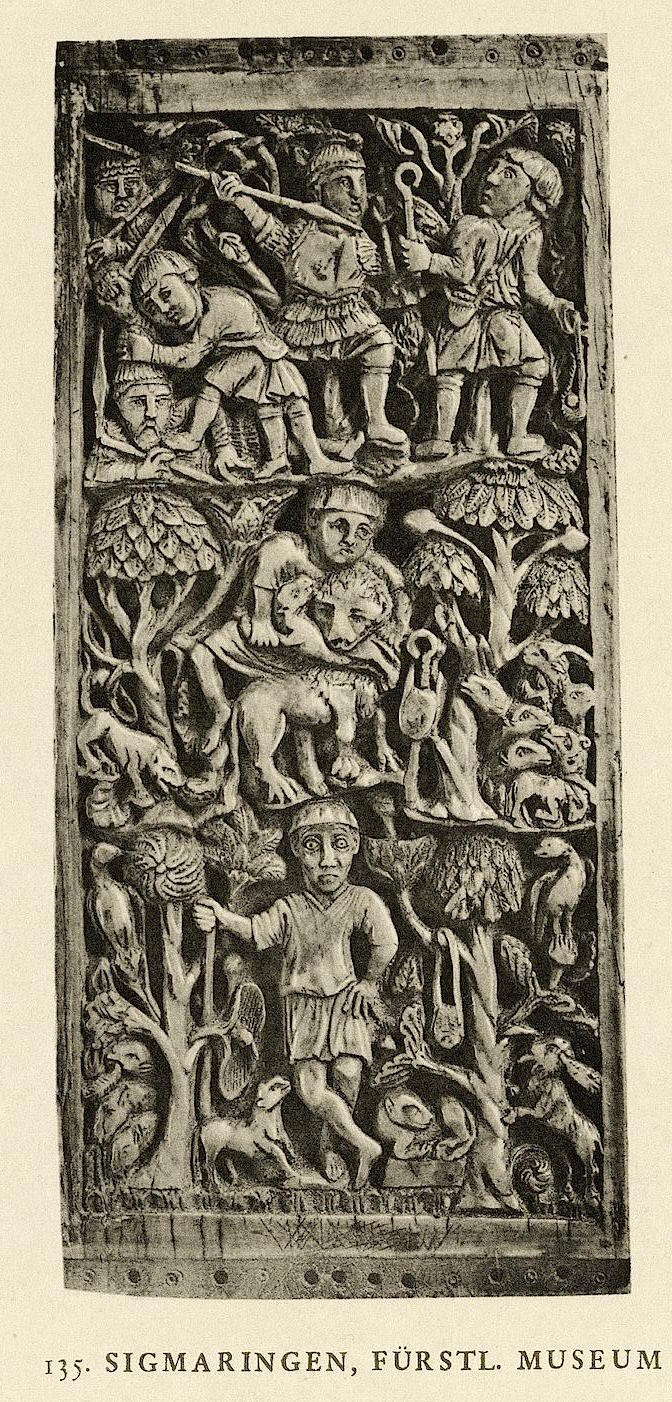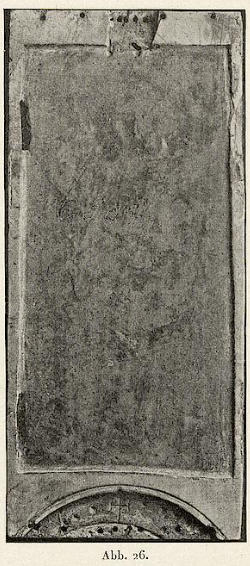135. BUCHDECKEL. TAFEL LVIII
David als Hirt und als Sieger über Goliath.
Um 1000. Deutsch.
Sigmaringen, Fürstliche Sammlung, Inv. 688o
Höhe 15,5 cm, Breite 7 cm.
Erhaltung gut, bis auf ganz kleine herausgebrochene Stücke an Stab und Lanze und an der Hand Davids in der oberen Szene.
Die Rückseite der Platte (Abb. 26) läßt erkennen, daß es sich um den Teil einer ursprünglich größeren Elfenbein-tafel handelt;
sie zeigt eine oblonge vertliefte Fläche für Wachs, die aber nicht bis ganz hinunterreicht, sondern auf dem unteren Teil sieht man noch das Segment eines Kreisfeldes,
das auf eine Forsetzung nach unten, aber auch auf eine größere Breite der Platte schließen läßt, die durch den sehr schmalen Rand neben der Wachsvertiefung bestätigt wird.
In dieser befinden sich außerdem links (also von der Reliefseite aus rechts) am Rande zwei Schlitze zur Anbringung von Verbindungsbändern, rechts entsprechend Spuren von Verschlüssen.
Es ist möglich, daß dieses ältere Schreibdiptychon unterhalb der Rosette noch ein dem oberen entsprechendes Wachsfeld besaß,
womit die übliche Länge der alten Diptychen erreicht würde Als die Platte dann zerschnitten und mit den Davidszenen geschmuckte würde,
hat man den oberen und unteren Rand in einer Breite von etwa 4—5 mm zu einem dünneren Steg abgearbeitet, um ihn zum Einfalzen in einen Rahmen zu benutzen,
vermutlich als Einbanddeckel eines Psalteriums. Auf die Befestigung deuten zahlreiche Löcher in diesen Stegen.
Auffallend ist, daß die Seitenflächen der Ränder, auch an der unteren Schnittfläche des Kreissegmentes, mit kleinen Gruppen von eingepunzten Kreisen mit Mittelloch geziert sind,
wie sie sich auch auf den Flächen der Stege angebracht finden, so daß man annehmen muß, daß die Platte in iher jetzigen Abgrenzug zu irgendeiner Zait auch als ungefaßtes Stück,
vielleicht als Schreibtafel benutzt worden ist, vielleicht auch als Deckel eines Kastens,
denn an der oberen Seite der Wachsvertiefung auf der Rückseite ist ebenfalls ein längeres ausgeschnittenes Stück, dessen Bedeutung nicht klar ist.
An allen Teilen, auch an den Gesichtern, sind Reste von Vergoldung sichtbar.
Stammt aus der 1880 verkauften städtischen Sammlung von Volterra.
|
135. BOOK COVER. PLATE LVIII
David as shepherd and victor over Goliath.
Around 1000. German.
Sigmaringen, Princely Collection, Inv. 688o
Height 15.5 cm, width 7 cm.
Good condition, except for very small pieces broken off on the staff and spear and David's hand in the upper scene.
The back of the plate (Fig. 26) shows that it is part of an originally larger ivory panel;
it shows an oblong recessed area for wax, which does not reach all the way down, but on the lower part you can still see the segment of a circular field,
which suggests a continuation downwards, but also a greater width of the tablet through the very narrow margin next to the wax recess is confirmed.
In this there are also on the left (i.e. on the right from the relief side) two slots for attaching connecting straps, on the right there are corresponding traces of closures.
It is possible that this older writing diptych still had a wax field below the rosette corresponding to the upper one,
with which the usual length of the old diptychs would be reached about 4–5 mm worked off to a thinner bar in order to use it for folding into a frame,
presumably as the cover of a psaltery. Numerous holes in these bars indicate the attachment.
It is noticeable that the side surfaces of the edges, also on the lower cut surface of the circle segment, are decorated with small groups of punched circles with center holes, as they are also found on the surfaces of the bars, so that one must assume that the plate is in its current demarcation to any other time has also been used as an unmounted piece, perhaps as a writing board, perhaps also as the lid of a box, because on the upper side of the wax recess on the back there is also a longer cut-out piece, the meaning of which is not clear.
Remains of gilding are visible on all parts, including the faces. Comes from the Volterra municipal collection sold in 1880.
|
Die Darstellungen gruppieren sich in drei Reihen übereinander, Zu unterst steht David als Hirte mit gekreuzten Beinen und auf den Stab gestützt inmitten seiner Herde.
Am Baum hängt seine Schleuder. Darüber, ebenfalls zwischen Bäumen, entreißt er dem Löwen das Lamm, während rechts die Herde zusammengedrängt ist,
von links der Schäferhund herankommt.
In der obersten Reihe stehen sich David und Goliath gegenüber, der erstere mit Hirtenstab und Schleuder, der letztere vollständig gerüstet, die Lanze schwingend;
links daneben sieht man David, wie er dem gestürzten Riesen, dem der Stein noch in der Stirn sitzt, den Kopf abschlägt, Ein dahinterstehender Krieger blickt zu.
Nach der Art der Baume; besonders der sich wie Flechtwerk verästelnden der obersten Reihe,
scheint das Relief mit einer in der Maingegend zu lokalisierenden Schule um das Jahr 1000 verwandt zu sein.
Es gehörte daher eigentlich in den zweiten Band und steht hier etwas vereinzelt.
|
The representations are grouped in three rows one above the other. At the bottom, David stands as a shepherd with crossed legs and leaning on a staff in the midst of his flock. His sling hangs on the tree. Above, also between the trees, he snatches the lamb from the lion, while the herd is huddled together on the right and the sheepdog is approaching from the left. In the top row, David and Goliath face each other, the former with a shepherd's staff and slingshot, the latter fully armed, hefting his spear; to the left you can see David chopping off the head of the fallen giant with the stone still in his forehead. A warrior standing behind looks on.
According to the kind of trees; especially that of the top row, which branches out like braid, the relief seems to be related to a school located in the Main area around the year 1000. It actually belongs in the second volume and is a little isolated here.
|



